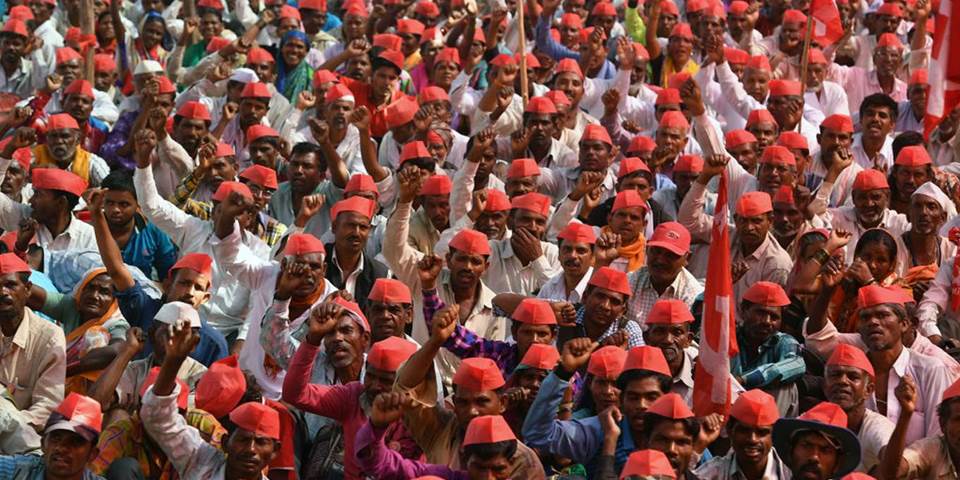
Um conjunto de três leis promulgadas pelo governo indiano em setembro deste ano, regulamentando o processo de comercialização de cereais está mobilizando a população rural da Índia. Em volume cada vez maior, manifestantes avançam em direção a Nova Delhi exigindo a revogação dos três documentos que foram aprovados coletivamente pelas duas casas legislativas – o Lok Sabha (Câmara Baixa), no dia 17, e o Rajya Sabha (Câmara Alta) – em 20 de setembro. Eles modificam o processo tradicional de comercialização de cereais que até então era feito através do “Comitê de Mercado de Produção Agrícola” (APMC), conselho criado pelos governos estaduais para garantir que os agricultores fossem protegidos da exploração pelos grandes varejistas. Os APMCs são atualmente regulados pelos governos estaduais.
O Centro afirma que a nova legislação visa proteger os lavradores na comercialização das suas colheitas junto às empresas de agronegócio -tanto processadores e atacadistas como grandes varejistas e exportadores -, sobretudo na alienação das colheitas futuras, através de um esquema de preços mutuamente lucrativo e acordado de forma justa e transparente, inserido no contexto de um sistema moderno, que estimule o empreendedorismo e a livre concorrência.
Então, por quê os protestos?
Cabe saber que pelo formato adotado há décadas, o governo indiano assegurava os preços para determinadas culturas, proporcionando aos lavradores uma garantia de longo prazo que lhes permitia fazer investimentos para o próximo ciclo da safra. Porém, estes agricultores eram obrigados a vender suas mercadorias em leilão no “Comitê de Mercado de Produção Agrícola” de seu estado, onde tinham a garantia de, pelo menos, obter o preço mínimo acordado pelo governo. Por extensão, as transações somente podiam ocorrer nos pátios dos mercados – “mandis” – da APMC. Havia restrições sobre quem poderia comprar nesses leilões e os preços se limitavam às mercadorias essenciais.
As novas leis definidas pelo governo do Primeiro-Ministro Narendra Modi desmontam esta estrutura, permitindo que os agricultores vendam seus produtos a qualquer um, e por qualquer preço. Ou seja, os agricultores têm mais liberdade para negociar com quaisquer compradores e vender para outros estados. Modi afirma que aumentar a concorrência no mercado é uma “coisa boa”, pois atende às demandas dos agricultores por uma renda mais alta e lhes dá novos direitos e oportunidades.
Isto porque em 2017, o Governo Central havia observado que uma série de reformas sugeridas pelo modelo de então não haviam sido implementadas, sobretudo no que respeita à lisura e aos objetivos do processo. Notou-se que a centralização redundava na redução da concorrência e consequente redução do número dos indivíduos e instituições envolvidos, derivando para verdadeiros monopólios das associações e abuso no que respeita às taxas de mercado, o que era muito prejudicial ao setor agrícola.
Cabe notar que a questão é vital para a Índia. A agricultura é a principal fonte de subsistência para cerca de 58% da população dos seus 1,3 bilhão de habitantes. Em termos políticos, também, os agricultores são o maior bloco eleitoral do país, tornando a agricultura numa questão central da política indiana. Tanto é assim que na data da promulgação da nova legislação, Modi referiu-se ao novo sistema como um “divisor de águas na história da agricultura indiana”, pois fortalece o poder de barganha de milhares de agricultores.
O Centro assinalou que antes da independência, em 1947, a maior preocupação do governo relacionada com a comercialização agrícola era manter em xeque os preços dos alimentos para os consumidores e os das matérias-primas destinadas à indústria. No entanto, após a independência, surgiu a necessidade de proteger os agricultores e fornecer-lhes preços que incentivassem a produção de “commodities”. Tornaram-se, então, muito comum em todo o país os problemas com indivíduos e empresas que extorquiam elevadas quantidades de grãos do agricultor a preços descartáveis, a título de juros. Reconhecendo as agruras que esses agricultores enfrentavam — como perdas decorrentes dos baixos valores indevidos, custos mais elevados de comercialização e consideráveis perdas físicas no processo de comercialização dos produtos— o Governo introduziu várias regulamentações obrigatórias, na esperança de estabelecer um mecanismo que monitore a conduta do mercado.
No entanto, desde a proposta destas leis de novembro, diferentes protestos vêm ocorrendo em distintos estados da Índia, especialmente no Punjab e em Haryana, onde os agricultores constituem a vanguarda na produção agrícola do país. Foi, aliás, nestas regiões que a chamada “Revolução Verde” teve lugar, em 1965, durante o governo da Primeira-Ministra Indira Gandhi, com a introdução de sementes híbridas, fertilizantes e a implantação de técnicas de irrigação que tornaram o país autossuficiente na produção de alimentos. A propósito, estes são os primeiros protestos de grandes agricultores desde que o governo de Narendra Modi chegou ao poder, em 2014.
A mudança enfureceu os agricultores indianos; eles dizem que as novas regras os deixarão expostos à voracidade das empresas que exploram os trabalhadores agrícolas, os quais compõem mais da metade da força de trabalho – cerca de 480 milhões de habitantes – da Índia, de acordo com o mais recente Censo, de 2011. Entre estes opositores estão aqueles que qualificam as leis de “favoráveis às empresas e anti-agricultores”, como é o caso de partidos da oposição; entre eles, o “Partido Comunista da Índia” e um partido “sikh” – maioria dos agricultores do Punjab -, o “Shiromani Akali Dal”. Um dos principais dilemas da oposição é a incerteza em torno da maneira pela qual as reformas “vão acontecer, na realidade”. Também pesam a controvérsia em torno dos preços mínimos, o efeito que a nova prática terá sobre os intermediários, a perda de receita dos Estados e o baixo poder de barganha dos agricultores. São estes alguns dos temores que levaram à oposição às ruas.
Entre os opositores destaca-se o reconhecido parlamentar Shashi Taroor, que tem larga vivência no contexto internacional, tendo ocupado cargos relevantes a ONU, inclusive. Sua voz é escutada por muitos formadores de opinião. Em artigo publicado no site “The Project Syndicate”, no ano passado, ele afirmou que…”a agricultura indiana está em crise. Os agricultores vivem um tormento. Durante o mandato de Modi, os custos dos insumos e, portanto, do cultivo, aumentaram de forma alarmante, enquanto os preços dos produtos agrícolas e, consequentemente, da renda agrícola, estagnaram ou caíram… muitos agricultores estão falidos…quando as culturas falham, muitos trabalhadores agrícolas que estão sob a carga esmagadora da dívida (muitas vezes derivada das taxas usurárias dos agiotas rurais) cometem suicídio – como mais de 11.400, em 2016.
É difícil prever para onde irão os protestos. Modi está irredutível, pois acredita que este é mais um passo importante para “aggiornar” o setor agrícola, um dos bastiões da economia indiana. Os manifestantes, de seu lado, temem tornar-se “escravos” do grande capital. Nesta “quebra de braços”, os analistas julgam que muita “água passará embaixo desta ponte”. Só que o que está em jogo é fundamental para a sobrevivência de mais de 1,3 bilhão de pessoas…
Recomendo aos amigos que leiam o texto de Shashi Tharoor, que embora antigo, permanece atual em muitos aspectos: Indian Farmers in Revolt
Doutor em Direito Internacional Público em Paris. Ingressou na carreira diplomática em 1976, serviu nas embaixadas de Bruxelas, Buenos Aires, Nova Déli, Washington, Pequim, Tóquio, Islamabade (onde foi Embaixador do Brasil, em 2004). Também cumpriu missões transitórias no Vietnã e Taiwan. Viveu 15 anos na Ásia, para onde orientou sua carreira por considerar que o continente seria o mais importante do século 21 – previsão que, agora, vê cada vez mais perto da realidade.
